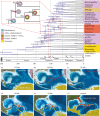A Cretaceous-aged Palaeotropical dispersal established an endemic lineage of Caribbean praying mantises
- PMID: 28954908
- PMCID: PMC5627202
- DOI: 10.1098/rspb.2017.1280
A Cretaceous-aged Palaeotropical dispersal established an endemic lineage of Caribbean praying mantises
Abstract
Recent phylogenetic advances have uncovered remarkable biogeographic histories that have challenged traditional concepts of dispersal, vicariance and diversification in the Greater Antilles. Much of this focus has centred on vertebrate lineages despite the high diversity and endemism of terrestrial arthropods, which account for 2.5 times the generic endemism of all Antillean plants and non-marine vertebrates combined. In this study, we focus on three Antillean endemic praying mantis genera, Callimantis, Epaphrodita and Gonatista, to determine their phylogenetic placement and geographical origins. Each genus is enigmatic in their relation to other praying mantises due to their morphological affinities with both Neotropical and Old World groups. We recovered the three genera as a monophyletic lineage among Old World groups, which was supported by molecular and morphological evidence. With a divergence at approximately 107 Ma, the lineage originated during the break-up of Gondwana. Ancestral range reconstruction indicates the lineage dispersed from an African + Indomalayan range to the Greater Antilles, with a subsequent extinction in the Old World. The profound ecomorphic convergence with non-Caribbean groups obscured recognition of natural relationships within the same geographical distribution. To the best of our knowledge, the lineage is one of the oldest endemic animal groups in the Greater Antilles and their morphological diversity and restricted distribution mark them as a critical taxon to conserve.
Keywords: Greater Antilles; Mantodea; biogeography; endemism; oceanic dispersal; phylogenetic.
© 2017 The Author(s).
Conflict of interest statement
The authors have no competing interests.
Figures


Similar articles
-
Epaphroditidae sensu novo, an Endemic Caribbean Family of Morphologically Divergent Praying Mantises (Insecta, Mantodea).Neotrop Entomol. 2018 Aug;47(4):502-507. doi: 10.1007/s13744-017-0570-7. Epub 2017 Dec 14. Neotrop Entomol. 2018. PMID: 29243117
-
Reconstructing the origins of praying mantises (Dictyoptera, Mantodea): the roles of Gondwanan vicariance and morphological convergence.Cladistics. 2009 Oct;25(5):468-514. doi: 10.1111/j.1096-0031.2009.00263.x. Epub 2009 Aug 25. Cladistics. 2009. PMID: 34879623
-
Towards a synthesis of the Caribbean biogeography of terrestrial arthropods.BMC Evol Biol. 2020 Jan 24;20(1):12. doi: 10.1186/s12862-019-1576-z. BMC Evol Biol. 2020. PMID: 31980017 Free PMC article.
-
The West Indies as a laboratory of biogeography and evolution.Philos Trans R Soc Lond B Biol Sci. 2008 Jul 27;363(1502):2393-413. doi: 10.1098/rstb.2007.2068. Philos Trans R Soc Lond B Biol Sci. 2008. PMID: 17446164 Free PMC article. Review.
-
Biogeography of the West Indies: A complex scenario for species radiations in terrestrial and aquatic habitats.Ecol Evol. 2021 Feb 10;11(6):2416-2430. doi: 10.1002/ece3.7236. eCollection 2021 Mar. Ecol Evol. 2021. PMID: 33767811 Free PMC article. Review.
Cited by
-
Exploring the Mitogenomes of Mantodea: New Insights from Structural Diversity and Higher-Level Phylogenomic Analyses.Int J Mol Sci. 2023 Jun 24;24(13):10570. doi: 10.3390/ijms241310570. Int J Mol Sci. 2023. PMID: 37445747 Free PMC article.
-
The earliest record of Caribbean frogs: a fossil coquí from Puerto Rico.Biol Lett. 2020 Apr;16(4):20190947. doi: 10.1098/rsbl.2019.0947. Epub 2020 Apr 8. Biol Lett. 2020. PMID: 32264782 Free PMC article.
-
A novel form of wasp mimicry in a new species of praying mantis from the Amazon rainforest, Vespamantoida wherleyi gen. nov. sp. nov. (Mantodea, Mantoididae).PeerJ. 2019 Oct 17;7:e7886. doi: 10.7717/peerj.7886. eCollection 2019. PeerJ. 2019. PMID: 31656699 Free PMC article.
-
Epaphroditidae sensu novo, an Endemic Caribbean Family of Morphologically Divergent Praying Mantises (Insecta, Mantodea).Neotrop Entomol. 2018 Aug;47(4):502-507. doi: 10.1007/s13744-017-0570-7. Epub 2017 Dec 14. Neotrop Entomol. 2018. PMID: 29243117
-
The first Gondwanan borioteiioid lizard and the mid-Cretaceous dispersal event between North America and Africa.Naturwissenschaften. 2018 Oct 5;105(11-12):61. doi: 10.1007/s00114-018-1588-3. Naturwissenschaften. 2018. PMID: 30291449
References
-
- Iturralde-Vinent M, MacPhee RDE. 1999. Paleogeography of the Caribbean region: implications for Cenozoic biogeography. Bull. Am. Mus. Nat. Hist. 238, 1–95.
-
- Rosen DE. 1975. A vicariance model of Caribbean biogeography. Syst. Zool. 24, 431–464. (10.2307/2412905) - DOI
MeSH terms
LinkOut - more resources
Full Text Sources
Other Literature Sources
Molecular Biology Databases

